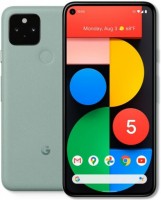Mobile Phones Google series Pixel 6
Google Pixel 6
The big news is that the Pixel is no longer a camera phone. In the sense that the camera is still excellent there, the specialists from DxOMark will not lie, but the company's marketers are shifting the focus to other things. For example, on the Tensor machine learning processor, over which Google sprinkled four years. The success of past pixels has shown that the quality of photos and videos taken with the camera largely depends not on the camera itself and the number of modules in it, but on the digital "brains" that read and interpret the data received from the camera. Therefore, Google decided to thoroughly pump these brains, at the same time using them in other tasks.
 |
Calling Tensor a processor is not quite right. Rather, it is a single-chip system with a bunch of components in the manner of the sensational Apple M1 SoC, which is in the new MacBooks and iPads. It combines 8 processor cores (2 powerful + 2 medium + 4 power efficient), with a 20-core graphics chip, as well as separate engines for enhancing security, machine learning and image processing. In fact, the new processor will help literally everywhere - for example, it will more clearly recognize the user's voice commands and better understand where punctuation marks are needed and where emoji are. Google says it's the most advanced speech recognition system on the market. And thanks to the new processor, it uses almost no battery resources. Also, the new processor helps process PINs and passwords faster (thanks to the Tensor Security Core chip) and is much better at simultaneous translation from photos and videos.
In the sixth generation of Pixel, according to tradition, two versions of the smartphone were presented: the classic Pixel and the upgraded Pixel Pro phablet. Both received a stylish design case made of metal and tempered glass, without a headphone output, but with IP68 water protection. The regular Pixel 6 got a 6.4-inch FHD+ screen with a refresh rate of up to 90Hz, while the Pixel 6 Pro has a 6.7-inch display with a 120Hz refresh rate. The camera of both smartphones is based on a new 1 / 1.31 ”sensor (50 MP resolution), which captures one and a half times more light than the sensor in the Pixel 5. At the same time, the regular Pixel 6 has a camera consists of two modules, the Pixel Pro 6 has a three. Additional features include laser autofocus and the ability to shoot video in 4K + 60 FPS.







